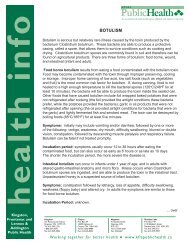Photovoice: - KFL&A Public Health
Photovoice: - KFL&A Public Health
Photovoice: - KFL&A Public Health
You also want an ePaper? Increase the reach of your titles
YUMPU automatically turns print PDFs into web optimized ePapers that Google loves.
<strong>Photovoice</strong>:<br />
See the bigger picture<br />
Participant Guide - East Region
<strong>Photovoice</strong><br />
is a method that enables people to define<br />
for themselves and others, including policy makers, what is<br />
worth remembering and what needs to be changed.<br />
¯<br />
Caroline Wang
Table of<br />
Contents<br />
Welcome to <strong>Photovoice</strong><br />
1<br />
• Background of <strong>Photovoice</strong> ................. 1<br />
• <strong>Photovoice</strong> Goals ..................................... 2<br />
How <strong>Photovoice</strong> Works 3<br />
What You Need to Know 5<br />
• Signing Up ..................................................................... 5<br />
• What to Take Pictures of? ...................................... 6<br />
• What are <strong>Health</strong> Issues ............................................ 6<br />
• What Matters to You? Worksheet ....................... 9<br />
<strong>Photovoice</strong> Guidelines 10<br />
• Invasion of Privacy ............................................. 10<br />
• Ethical Questions to Ask Yourself ............... 12<br />
Tips for Taking Good Pictures<br />
12<br />
Writing the Story of Your Photo<br />
15
Welcome to<br />
<strong>Photovoice</strong><br />
<strong>Photovoice</strong> is a photography project that allows you to explore and<br />
highlight issues around healthy living in your community, as it relates<br />
to tobacco use/exposure, healthy eating, physical activity, substance<br />
& alcohol misuse, mental health, dental health, sexual health and injury<br />
prevention. <strong>Photovoice</strong> provides a platform for you to discuss and plan<br />
social action using photography.<br />
<strong>Photovoice</strong> is organized by the Eastern Ontario region Tobacco<br />
Control Area Network (TCAN) and is funded by the Smoke-Free<br />
Ontario Strategy.<br />
Background of <strong>Photovoice</strong><br />
(*Adapted from <strong>Photovoice</strong> Hamilton’s Manual, 2007)<br />
Photography as a medium has shaped modern culture significantly.<br />
In particular, the rise of “photojournalism” enabled both the fascinating<br />
and the heartbreaking to be shared through pictures. <strong>Photovoice</strong><br />
creator Caroline Wang started the project in the early 1990’s with<br />
women living in rural China who used photography as a way to<br />
increase awareness of social inequality. By distributing cameras<br />
and encouraging conversations and advocacy, the participants successfully<br />
influenced the policies and programs that served them.<br />
The <strong>Photovoice</strong> project is based on ‘Participatory Action Research’<br />
which proposes that the entire project, from its conception and<br />
design through to every step of the research is done by the<br />
participants whenever possible. When the research is finished,<br />
the participants themselves “own” the data and decide how to<br />
publish or share this information. The whole idea of <strong>Photovoice</strong><br />
is to put the power back into the hands of those who usually<br />
don’t have much power. Youth in many communities feel they<br />
are not listened to or that they do not have a voice.<br />
1
<strong>Photovoice</strong> is your chance to share ideas about<br />
health issues in your community and advocate for<br />
change.<br />
<strong>Photovoice</strong> has four goals:<br />
1. It encourages you to record and think about your<br />
community’s strengths and problems.<br />
2. It identifies important issues through photographs<br />
and narratives.<br />
3. It gets the attention of politicians and other<br />
decision makers.<br />
4. It works towards positive changes in your community.<br />
2
How it<br />
Works . . .<br />
Get out there!<br />
• Use your own digital camera, your cell phone or disposable<br />
cameras to take pictures that document issues around health in your<br />
community. Answer the question “Does my community make it easier<br />
– or not – for me to be healthy?” by using photography.<br />
Be heard and validated!<br />
• Use the participant guide to create a photo story for each photograph.<br />
See the bigger picture!<br />
• View your photos on the Smoke Free East website (smokefreeeast.ca).<br />
Share your photos and thoughts and view what others in your area<br />
are taking pictures of and the stories being told.<br />
Find your voice!<br />
• Work with peers in your community during this project and/or an<br />
adult ally (i.e. teacher, guidance counselor, a mentor) and discuss<br />
what the photos mean to you, your peers and your school/community.<br />
• Participate in the photo gala in your community at the end of the<br />
project. Let others see what you have accomplished. You will be<br />
eligible to win great prizes!<br />
Advocate for social action and change!<br />
• Work with a peer group, adult ally, or the public health unit to come<br />
up with a plan of action for change. What are some common picture<br />
themes in your community? What changes do you think need<br />
to be made? How can you make those changes happen?<br />
• Your pictures will be used to help set priorities and develop policies<br />
that will promote the reduction of tobacco use/exposure,<br />
healthy eating, physical activity, substance & alcohol misuse,<br />
mental health, dental health, sexual health and injury prevention.<br />
More information can be found throughout the guide.<br />
3
<strong>Photovoice</strong> will run from:<br />
October 11, 2011 to November 30, 2011<br />
Your <strong>Photovoice</strong> contact will be:<br />
Nicole Szumlanski,<br />
Tobacco Information Line<br />
613-549-1232 or 1-800-267-7875, ext. 1333<br />
Online: www.kflapublichealth.ca<br />
Email: til@kflapublichealth.ca<br />
Fax: 613-549-7896<br />
4
What you need to<br />
Know<br />
Step 1: Register to participate<br />
Fill out the consent form which can be downloaded from<br />
www.kflapublichealth.ca. If you are under the age of 18, a parent or<br />
guardian will need to sign the form. Forms can be submitted via e-mail,<br />
fax, or mail to the photovoice contact. You should be aware that upon<br />
signing this consent form, all pictures submitted will become the<br />
property of the Tobacco Control Area Network in Eastern Ontario<br />
including KFL&A <strong>Public</strong> <strong>Health</strong>, and will be used to promote the <strong>Photovoice</strong><br />
project as well as in other potential health related programs.<br />
Step 2: Take pictures!<br />
Go out and take pictures! Remember that photos should be of places<br />
and objects. We ask that you stay away from taking pictures of people<br />
where the individual can be identified. If people are in the photos,<br />
have them turn away from the camera so their likeness is not recognizable<br />
(i.e. don’t photograph their face, take pictures with their back turned<br />
to the camera, crop the photo or blur the faces). If you take a great<br />
photo with someone in it and you want to submit it but don’t have<br />
the technical capabilities contact your <strong>Photovoice</strong> contact.<br />
<strong>Photovoice</strong> will cover the cost of developing up to 24 copies of 4x8<br />
pictures as well as enlarged pictures for display at the photo gala.<br />
You are encouraged to use your own camera however; disposable<br />
cameras will be provided to you if needed. To obtain a disposable<br />
camera and to inquire about developing your pictures contact<br />
your <strong>Photovoice</strong> contact.<br />
5<br />
Step 3: Upload your pictures<br />
To submit your pictures and ‘Description of Pictures’ form,<br />
send them by email to til@kflapublichealth.ca or online at<br />
www.kflapublichealth.ca within an e-mail.
Once reviewed your pictures will go up on the Smoke Free East website as<br />
part of a slideshow and you will have a chance to win great prizes!<br />
What to take<br />
Pictures Of?<br />
Some ideas to get you started…<br />
• What do you see in your everyday life that affects your health? You could take<br />
your camera with you, and make a “photo essay” about a typical day for you.<br />
Afterwards, look at the pictures, and see what stands out for you.<br />
• Start with an opinion or idea. Have you ever wanted to write a letter to the editor<br />
of a newspaper about issues effecting youth in your community? What would<br />
you say? Now, try to create a picture that gets your idea across.<br />
• Make a collection of pictures showing all the things you are proud of in<br />
your community.<br />
• Make a collection of pictures showing all the things about your community<br />
you are disappointed with.<br />
• Use your emotions as a cue. Consider where you live and how you live… what gives<br />
you a strong emotional response (excited, angry, afraid, sad…)? Tell the story.<br />
• What is important to you? What is a big part of your life?<br />
Take pictures of objects, possessions, services, places…<br />
Please ensure photos capture a health issue that matters to you.<br />
What are<br />
<strong>Health</strong> Issues?<br />
<strong>Health</strong> issues are important topics or problems that are currently affecting<br />
individual, group, or community well-being. This question list will help to get you<br />
started thinking about how to view health issues in your community and what to<br />
take pictures of.<br />
6
Tobacco Use and Substance Use<br />
• Is smoking an issue at your school or in your community? Do you have<br />
to walk through a haze of smoke to get to your job/school?<br />
• Do you see alcohol or drug misuse as a serious issue in your community?<br />
• How is alcohol advertising targeting youth in your community?<br />
<strong>Health</strong>y Eating<br />
• Are healthy options in school/community cafeterias/vending machines<br />
readily available?<br />
• Are there a number of grocery stores or farmers’ markets available?<br />
• Are there many fast food restaurants and unhealthy options in your<br />
community?<br />
Physical Activity<br />
• Do you have access to locations to exercise i.e. community centres,<br />
recreation centres, or outdoor spaces? Are new condominiums being<br />
built where your favourite park is?<br />
• Is not exercising a problem (i.e. watching TV, playing on the computer,<br />
playing video games all day)?<br />
• Are you lacking recreation areas (i.e. a skate park, tennis courts,<br />
mountain bike trails)?<br />
Mental <strong>Health</strong><br />
• Are there issues or pressures around body image i.e. advertisements,<br />
billboards?<br />
• Is stress (i.e. school, work, relationships) an issue? What about access<br />
to resources and help?<br />
Dental <strong>Health</strong><br />
• Are mouth piercings (i.e. tongue, lip) popular?<br />
• Do you and your peers have access to regular dental treatments?<br />
7<br />
Sexual <strong>Health</strong><br />
• What issues around healthy sexuality do you and your peers deal<br />
with?
• Are protective measures (i.e. condoms) and education readily accessible?<br />
Injury Prevention<br />
• Do people wear helmets when biking and skateboarding?<br />
• Are there hazards in your neighbourhood that could cause harm (i.e. needles/<br />
broken glass in parks, lack of street lights)?<br />
The Environment<br />
• Is there a pollution problem in your area (i.e. cars, smoking, water, or factories)?<br />
• Are cigarette butts or garbage littered all over your favourite park or beach?<br />
• Are there lack of options for recycling and composting in your community?<br />
• Are there bike lanes, bike racks and sidewalks in your community?<br />
• Are buildings/parks accessible for disabled persons and/or seniors?<br />
8
What Matters<br />
to You?<br />
If you are struggling with what to take pictures of, try filling<br />
out these questions and see if you get inspired.<br />
Think about: WHERE YOU LIVE, and HOW YOU LIVE …<br />
Things I am proud of…<br />
Inside me:<br />
Close to me:<br />
Wider Community:<br />
Things that need to change…<br />
Inside me:<br />
Close to me:<br />
Wider Community:<br />
9<br />
Now, think of an image or picture that would tell this.
<strong>Photovoice</strong><br />
Privacy Guidelines<br />
These guidelines are important to remember when taking pictures,<br />
particularly to remain ethical, keep you safe and to protect the privacy<br />
of those you may be photographing.<br />
• Always ask before taking a photo of someone’s personal property<br />
(ex. someone’s house).<br />
• Be respectful.<br />
• Use a buddy system, especially when going to places you are not<br />
familiar with.<br />
• Don’t do anything you wouldn’t usually do.<br />
• Don’t go anywhere you wouldn’t usually go.<br />
• When confronted by someone aggressively, stay calm, do not resist,<br />
and give up the camera<br />
• Be aware of your surroundings.<br />
• Stay safe!<br />
• ASK FIRST before taking a photo.<br />
Invasion of privacy<br />
While we want you to get the best photos possible, we don’t want you<br />
to get in trouble for the sake of a picture. Here are a few suggestions to<br />
stay safe and to stay within the law.<br />
<strong>Public</strong> versus private property<br />
You are free to take photos of any object or building you see as long as<br />
you are on public property (for example, if you’re standing on the sidewalk<br />
and see a big box store being built where your favourite park once<br />
stood, you can definitely get that shot).<br />
Examples of public property:<br />
• A park • Town squares • The sidewalk<br />
• Shopping malls (be careful, a mall is public AND private—you can take<br />
photos inside but if asked to leave by security, then you must leave)<br />
Notes: Legally, you are allowed to take photos of people’s homes<br />
10
from the sidewalk. For this project, we DO NOT want photos of private residences.<br />
You cannot photograph military bases, nuclear plants, arms factories,<br />
because then it would become an issue of national security.<br />
Trespassing: This is going on to someone’s private<br />
property (like your neighbour’s front lawn). If someone<br />
tells you to leave, you must leave immediately.<br />
Always ask permission first.<br />
Do not tell anyone you are someone you are not. Do not<br />
lie to or manipulate people to get your photo.<br />
Privacy<br />
When choosing subjects for your photos you have to<br />
consider people’s right to privacy. You cannot take a<br />
picture of someone without their permission if they are<br />
in locations where there is the expectation of privacy:<br />
• In the home.<br />
• In the bathroom/change room at the gym.<br />
You also have to be careful of how you portray the<br />
subject in the photo. For example, if you decide that<br />
you want your photo to show that drug abuse is a serious<br />
problem in your neighbourhood park, you can’t just<br />
take a picture of someone in the park. Then it is implied<br />
that the person in the picture is a drug user, when this<br />
might not necessarily be the case. Instead ask a friend,<br />
who knows what your photo is about, if he or she is willing<br />
to pose in the picture instead. Once again remember,<br />
people in the photos should NOT be recognizable,<br />
even if the photos are staged (i.e. don’t photograph<br />
their face, take pictures with their back turned to the<br />
camera, crop the photo or blur the faces).<br />
11
Ethical Questions to Ask Yourself<br />
(Taken from the <strong>Photovoice</strong> Procedural Manual: Port Colorne/Wainfleet<br />
FOCUS Resource Centre)<br />
• If I put myself in the person’s place, how would I feel?<br />
• What am I saying with this picture?<br />
• Do I have permission to take this picture?<br />
• Am I being respectful of privacy?<br />
• What are the risks of taking this picture?<br />
• What are the benefits of taking this picture?<br />
• What can I influence with this picture?<br />
Tips for taking<br />
Good Pictures<br />
1. Use a plain background<br />
A plain background shows off the object or landscape you are<br />
photographing. When you look through the camera viewfinder, force<br />
yourself to study the area surrounding your subject.<br />
2. Use flash outdoors<br />
Bright sun can create unattractive facial shadows. Eliminate the shadows<br />
by using your flash to lighten the object.<br />
3. Move in close<br />
Your goal is to fill the picture area with the object you are photographing.<br />
Up close you can reveal telling details, like tiny words on the side of a<br />
distant building. But don’t get too close or your pictures will be blurry.<br />
4. Move it from the middle<br />
Center-stage is a great place for a performer to be. But, the middle<br />
of your picture is not always the best place for your object. Bring<br />
your picture to life by simply moving your subject away from the<br />
middle of the picture.<br />
12
5. Lock the focus<br />
Usually you can lock the focus in 3 steps: 1. center the object & press<br />
and hold the shutter button halfway down; 2. reposition your camera<br />
(still holding the shutter button) so the object is no longer in the center;<br />
3. press the shutter button all the way down to take the picture.<br />
6. Know your flash's range<br />
The number one flash mistake is taking pictures beyond the flash’s<br />
range. Pictures taken beyond the maximum flash range will be too<br />
dark. For many cameras, the maximum flash range is less than 15<br />
feet. To be safe, position yourself so objects are no farther than 10<br />
feet away.<br />
7. Watch the light<br />
Next to the object, light is the most important part of every photo.<br />
It affects the appearance of everything you photograph. Try taking<br />
landscapes early or late in the day when the contrasts and colors<br />
are more pronounced.<br />
8. Take some vertical pictures<br />
Is your camera vertically challenged? It is if you never turn it sideways<br />
to take a vertical picture. Try turning your camera sideways<br />
and look at the world from a different angle.<br />
9. Be a picture director<br />
Take control of your picture-taking and watch your pictures dramatically<br />
improve. Pick the location and add props. Take charge of your<br />
pictures!.<br />
For more photo-taking tips and techniques visit these<br />
websites:<br />
13<br />
Kodak: Tips and Projects Centre<br />
http://www.kodak.com/eknec/PageQuerier.jhtml?pqpath=38/13915&pq-locale=en_CA
HP: DEMO: Simple tips for taking better photos<br />
http://www.hp.com/united-states/consumer/<br />
digital_photography/take_better_photos/<br />
index.html<br />
14
S “What is seen here?” (Describe what the eye sees)<br />
O “How does this relate to our lives?” (or my life personally)<br />
D “What can I do about it?” (What will I or we do about it?)”<br />
Writing the story of<br />
Your Photo<br />
Here are some worksheets to help you write the story of<br />
your photo*.<br />
SHOWED - If having trouble writing the ‘story’ of your photo,<br />
try answering these questions.<br />
Title of Picture: Date:<br />
H “ What is really happening?” (The unseen “story”<br />
behind the image)<br />
W “Why are things this way?”<br />
E “How could this image educate people?”<br />
(*Taken from Simcoe & Muskoka District <strong>Health</strong> Unit’s <strong>Photovoice</strong> Participant Booklet).<br />
15
17<br />
Notes
Notes<br />
18
19<br />
Notes
















